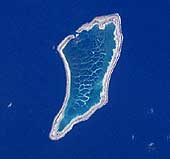|
COMETS EARTH JUPITER KUIPER BELT MARS MERCURY METEORITES NEPTUNE OORT CLOUD PLUTO SATURN SOLAR SYSTEM SPACE SUN URANUS VENUS ORDER PRINTS
PHOTO CATEGORIES SCIENCEVIEWS AMERICAN INDIAN AMPHIBIANS BIRDS BUGS FINE ART FOSSILS THE ISLANDS HISTORICAL PHOTOS MAMMALS OTHER PARKS PLANTS RELIGIOUS REPTILES SCIENCEVIEWS PRINTS
|
Related Document
Download Options
Canton Atoll is a good example of a long-lived coral atoll. Like Tupai, it probably originated as a fringing reef developed around a volcanic island that has long since disappeared. Unlike Tupai, however, it is far distant from any above-surface volcanic structure. Its parent volcano long ago subsided deep beneath the sea. The atoll lies only 2.5° from the equator and is subjected to long periods of drought. Although it is the largest island in the Phoenix group, only 9 square kilometers (3.5 square miles) rise above sea level. The island was discovered in the early 19th century and was named after an American whaling ship wrecked there in 1854. For several decades, American companies extracted the valuable guano. However, in the 20th century, Canton's attraction was as a refueling stop for aircraft on long-haul flights across the Pacific. Hence, the island has a long runway on the north shore and the designation, on maps, of the lagoon as a seaplane anchorage. However, advances in aircraft design eliminated the island's role as a refueling stop. With no economic role and insufficient soil to support crops, the island does not support permanent habitation. Patterns of coral heads growing within the shallow water of the lagoon are clearly visible as a thin white network. |
